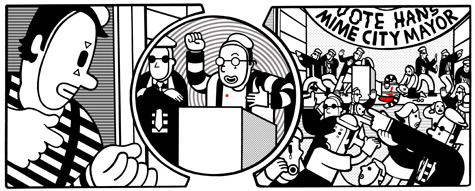Regardless of one’s definition of “Grand Success,” the fact remains that North makes his living from Dinosaur Comics’ advertisements and merchandise sales. (North: “When I graduated from grad school it was ‘continue doing comics’ or ‘get a real job’ and I went with the option that seemed more awesome.”) His first official book, Dinosaur Comics: Your Whole Family Is Made Out of Meat, was released last year, and with the comic’s popularity continuing to rise, it can be safely assumed that more are in the works. As it retains its blissful sameness, it’s clear that Dinosaur Comics has quite the road ahead of it. Recent subject matter: Internet business models, Rene Descartes, and things T-Rex is unable to fit into his mouth.
THE PERRY BIBLE FELLOWSHIP

Two brothers ride a rollercoaster in celebration of their father’s death. Mime City’s mayoral candidate is assassinated with an invisible rifle. A pirate’s life is saved with a wooden aorta during open-heart surgery. In his comic, The Perry Bible Fellowship, Nicholas Gurewitch tackles these situations with hilarity and artistic panache that belies the ridiculousness of most of his premises.
The PBF, as it has come to be known, got its start in Gurewitch’s college newspaper. When Gurewitch put his entire inventory of comics on the web, however, “the e-mail addresses of fan-mail stopped ending with ‘syr.edu’ and started ending with ‘co.uk’ and ‘com.nz’.” Since then, Gurewitch’s comics have become standbys on message boards and dorm room walls everywhere.
The art style of the PBF runs the gamut from hilarious, over-the-top simplicity to gloomy Edward Gorey-style crosshatch. Many of Gurewitch’s early characters take the form of what have come to be called “doughboys.” White and featureless save clothing, eyes, and mouths, the doughboys have remained in more recent PBF strips, occasionally replaced by characters of far more detail and complexity. The skill and care Gurewitch clearly places into each PBF strip both silences anyone who may criticize webcomics an amateurish medium and does something nearly unheard of in the form: it pulls off hilarious sight gags.
The runaway ― wait for it ― viral popularity of the PBF has been a blessing and a curse for Gurewitch, who still considers his comic primarily a print work. Both formats have their “unexpected quirks,” he says, but “everything on the internet is everybody else's. Someone can take a comic of mine, or two, or ten, and stamp the logo of their own site on the thing, and post it on their site. That's annoying as hell.” As a result of this, Gurewitch oftentimes makes slight changes between the online and print versions of his work, as if to reward the people who receive his content straight from the horse’s mouth.
Though Gurewitch has to chalk his work’s popularity to the distribution power of the internet, he makes much of his status as a traditionalist in terms of the power of print in the comic medium. “I can't imagine why anyone would prefer an artificial, electronic imitation of something over the real thing,” he says. “There's something wonderful, and soon-to-be mythic about the printed page. Better for the eyes too. I'll always prefer it.”
There remains a certain facet of Gurewitch, though, that appreciates any kind of distribution of his work. “I continue [creating comics], I think, because I've always enjoyed the sight of a person laughing at something I've drawn,” he says. “It appeals to some terrible, reptilian part of my brain that thirsts for control and power.”
The PBF has found itself printed in publications ranging from the Guardian to Maxim, and the idea of seeing it, with its recurring themes of suicide, dashed childhood dreams and violence, run next to Cathy or Family Circus in a mainstream newspaper is something that, however unlikely it might seem, would only serve to further delight the throngs of fans who appreciate exquisitely drawn comics concerning astronomers using their telescopes to look at nude beaches.
CAT AND GIRL

Dorothy Gambrell, age 28, recently made a trip all the way around the world without using an airplane. Even more recently, she created a map of New York City color-coded by number of residents per McDonald’s restaurant. For the last five years, she has been charting her ten closest friends in the New York area by education, sexuality, borough of residence, employment status and other criteria. For roughly that amount of time, she has also been creating Cat and Girl, a comic concerning “a cat, a girl, and an experimental meta-narrative.”
“I decided to be a cartoonist when I was nine years old because I thought it sounded like an easy job,” says Gambrell. Elaborating on the origins of her career, she adds “Cat and Girl began in June of 1999 as a weekly cartoon that was distributed by me walking around and taping it to doors and storefronts in Western Massachusetts. I used a computer in its creation primarily because the student computer center charged for photocopies, but printouts were free. My friend Chris was a big fan of [early absurd, profane webcomic] Space Moose and wanted me to put the cartoons online, so as soon as I had an archive of about four cartoons, online they went.”